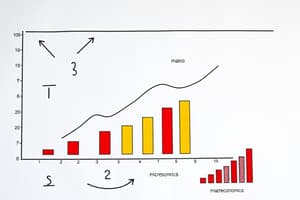Podcast
Questions and Answers
अर्थशास्त्र का क्या अर्थ है?
अर्थशास्त्र का क्या अर्थ है?
- संसाधनों के उत्पादन के अध्ययन
- राजनीतिक संरचनाओं का अध्ययन
- लोगों और समाजों द्वारा सीमित संसाधनों का उपयोग करने का अध्ययन (correct)
- आर्थिक नीतियों का अध्ययन
स्रोतों की कमी का क्या प्रभाव होता है?
स्रोतों की कमी का क्या प्रभाव होता है?
- स्रोतों का अधिक उत्पादन करना
- किसी एक विकल्प को प्राथमिकता देना (correct)
- सभी संभावित विकल्पों का उपयोग करना
- किसी भी विकल्प को न चुनना
इसका क्या उदाहरण है जब एक सूची को एकत्रित किया जाता है?
इसका क्या उदाहरण है जब एक सूची को एकत्रित किया जाता है?
- समान्य सामूहिक लाभ
- उपलब्धता और मांग में वृद्धि (correct)
- उत्पादन की संख्या में वृद्धि
- कम कीमतों पर बिक्री करना
संविधान में किस प्रकार की आर्थिक प्रणाली शामिल है?
संविधान में किस प्रकार की आर्थिक प्रणाली शामिल है?
GDP के बारे में सही विवरण क्या है?
GDP के बारे में सही विवरण क्या है?
मौद्रिक नीति का उद्देश्य क्या होता है?
मौद्रिक नीति का उद्देश्य क्या होता है?
महानता के उदाहरणों में से एक क्या है?
महानता के उदाहरणों में से एक क्या है?
अंतरराष्ट्रीय अर्थशास्त्र में व्यापार का क्या महत्व है?
अंतरराष्ट्रीय अर्थशास्त्र में व्यापार का क्या महत्व है?
Study Notes
Key Concepts in Economics
1. Definitions
- Economics: The study of how individuals and societies allocate scarce resources to satisfy unlimited wants.
- Microeconomics: Focuses on the behavior of individuals and firms in making decisions regarding the allocation of resources.
- Macroeconomics: Examines the economy as a whole, including inflation, unemployment, and national income.
2. Fundamental Economic Principles
- Scarcity: Limited resources lead to competition and prioritization of needs and wants.
- Supply and Demand: Prices fluctuate based on the relationship between the quantity supplied and quantity demanded.
- Opportunity Cost: The cost of the next best alternative forgone when making a decision.
3. Economic Systems
- Capitalism: Economic system where private individuals own and control property and businesses.
- Socialism: Economic system where the government owns and controls major industries and services, aiming for equal distribution of resources.
- Mixed Economy: Combines elements of capitalism and socialism.
4. Key Economic Indicators
- Gross Domestic Product (GDP): Total value of all goods and services produced in a country over a specific time period.
- Unemployment Rate: Percentage of the labor force that is jobless and actively seeking employment.
- Inflation Rate: The rate at which the general level of prices for goods and services is rising.
5. Market Structures
- Perfect Competition: Many firms, identical products, no barriers to entry.
- Monopoly: Single firm dominates the market, significant barriers to entry.
- Oligopoly: Few firms control the market, products may be identical or differentiated.
6. Fiscal and Monetary Policy
- Fiscal Policy: Government spending and tax policies used to influence the economy.
- Monetary Policy: Central bank actions to control the money supply and interest rates to achieve macroeconomic goals.
7. International Economics
- Trade: The exchange of goods and services across borders, which can be influenced by tariffs, quotas, and trade agreements.
- Foreign Exchange Market: A global decentralized market for trading currencies.
8. Behavior and Decision-Making
- Utility: The satisfaction or benefit derived from consuming goods and services.
- Marginal Analysis: Examining the additional benefits of an activity compared to the additional costs.
9. Economic Theories
- Classical Economics: Emphasizes free markets, competition, and the self-regulating nature of the economy.
- Keynesian Economics: Advocates for government intervention to manage economic cycles, especially during recessions.
10. Current Economic Issues
- Globalization: Increasing interdependence of economies through trade and investment.
- Income Inequality: The unequal distribution of income and wealth within a population.
- Sustainability: Balancing economic growth with environmental protection and social equity.
अर्थशास्त्र में प्रमुख अवधारणाएं
- अर्थशास्त्र: यह अध्ययन है कि व्यक्ति और समाज कैसे सीमित संसाधनों को अनंत इच्छाओं को पूरा करने के लिए आवंटित करते हैं।
- सूक्ष्म अर्थशास्त्र: यह संसाधनों के आवंटन के संबंध में निर्णय लेने में व्यक्तियों और फर्मों के व्यवहार पर ध्यान केंद्रित करता है।
- स्थूल अर्थशास्त्र: यह मुद्रास्फीति, बेरोजगारी और राष्ट्रीय आय सहित अर्थव्यवस्था को समग्र रूप से जांचता है।
मौलिक आर्थिक सिद्धांत
- दुर्लभता: सीमित संसाधन प्रतिस्पर्धा और आवश्यकता और इच्छाओं को प्राथमिकता देने की ओर ले जाते हैं।
- आपूर्ति और मांग: पूर्ति की गई मात्रा और मांगी गई मात्रा के बीच के संबंध के आधार पर कीमतें बदलती रहती हैं।
- अवसर लागत: निर्णय लेते समय छोड़े गए अगले सर्वोत्तम विकल्प की लागत।
आर्थिक प्रणालियाँ
- पूंजीवाद: एक आर्थिक प्रणाली जहाँ निजी व्यक्ति संपत्ति और व्यवसायों का स्वामित्व और नियंत्रण करते हैं।
- समाजवाद: एक आर्थिक प्रणाली जहाँ सरकार प्रमुख उद्योगों और सेवाओं का स्वामित्व और नियंत्रण करती है, संसाधनों के समान वितरण का लक्ष्य रखती है।
- मिश्रित अर्थव्यवस्था: पूंजीवाद और समाजवाद के तत्वों को जोड़ती है।
प्रमुख आर्थिक संकेतक
- सकल घरेलू उत्पाद (जीडीपी): किसी देश में एक निश्चित समय अवधि में उत्पादित सभी वस्तुओं और सेवाओं का कुल मूल्य।
- बेरोजगारी दर: श्रम बल का प्रतिशत जो बेरोजगार है और सक्रिय रूप से रोजगार की तलाश में है।
- मुद्रास्फीति दर: वह दर जिस पर वस्तुओं और सेवाओं के लिए सामान्य मूल्य स्तर बढ़ रहा है।
बाजार संरचनाएँ
- पूर्ण प्रतियोगिता: कई फर्म, समान उत्पाद, प्रवेश में कोई बाधा नहीं।
- एकाधिकार: एकल फर्म बाजार पर हावी है, प्रवेश में महत्वपूर्ण बाधाएं।
- अल्पाधिकार: कुछ फर्म बाजार को नियंत्रित करते हैं, उत्पाद समान या विभेदित हो सकते हैं।
राजकोषीय और मौद्रिक नीति
- राजकोषीय नीति: अर्थव्यवस्था को प्रभावित करने के लिए उपयोग किए जाने वाले सरकारी व्यय और कर नीतियां।
- मौद्रिक नीति: स्थूल आर्थिक लक्ष्यों को प्राप्त करने के लिए मुद्रा आपूर्ति और ब्याज दरों को नियंत्रित करने के लिए केंद्रीय बैंक की कार्रवाई।
अंतर्राष्ट्रीय अर्थशास्त्र
- व्यापार: सीमा पार वस्तुओं और सेवाओं का आदान-प्रदान, जिसे टैरिफ, कोटा और व्यापार समझौतों से प्रभावित किया जा सकता है।
- विदेशी मुद्रा बाजार: मुद्राओं के व्यापार के लिए एक वैश्विक विकेंद्रीकृत बाजार।
व्यवहार और निर्णय लेना
- उपयोगिता: वस्तुओं और सेवाओं का उपभोग करने से प्राप्त संतुष्टि या लाभ।
- सीमांत विश्लेषण: अतिरिक्त लागतों की तुलना में किसी गतिविधि के अतिरिक्त लाभों की जांच करना।
आर्थिक सिद्धांत
- शास्त्रीय अर्थशास्त्र: मुक्त बाजारों, प्रतिस्पर्धा और अर्थव्यवस्था की स्व-नियमन प्रकृति पर जोर देता है।
- केनेसियन अर्थशास्त्र: मंदी के दौरान विशेष रूप से, आर्थिक चक्रों को प्रबंधित करने के लिए सरकारी हस्तक्षेप की वकालत करता है।
वर्तमान आर्थिक मुद्दे
- वैश्वीकरण: व्यापार और निवेश के माध्यम से अर्थव्यवस्थाओं की बढ़ती अन्योन्याश्रयता।
- आय असमानता: किसी आबादी के भीतर आय और धन का असमान वितरण।
- टिकाऊपन: पर्यावरण संरक्षण और सामाजिक न्याय के साथ आर्थिक विकास को संतुलित करना।
Studying That Suits You
Use AI to generate personalized quizzes and flashcards to suit your learning preferences.
Description
यह क्विज़ अर्थशास्त्र के महत्वपूर्ण सिद्धांतों पर आधारित है, जिसमें सूक्ष्म और व्यापक अर्थशास्त्र, आपूर्ति और मांग का सिद्धांत, और विभिन्न आर्थिक प्रणालियों जैसे पूंजीवाद और समाजवाद को कवर किया गया है। प्रत्येक अवधारणा को समझने के लिए प्रश्नों के माध्यम से ज्ञान का परीक्षण करें।




